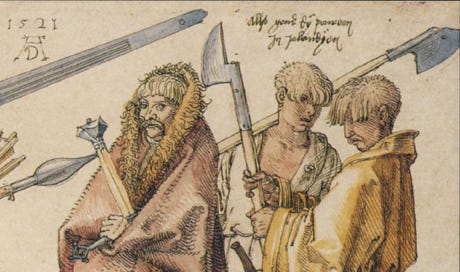The Duhare: A Gaelic Colony in North America Nearly 500 Years Ago
Fairy skinned "giants" of what is now the Mid Atlantic States of the USA
Three Irish Men by Albert Durer 1521
Although it is generally acknowledged today that Christoper Columbus and his murderous flotilla were probably among the last to 'discover' North America—as just about every other sea faring culture from around the Atlantic and Pacific were exploring the Americas for thousands of years prior—a lost piece of history has produce evidence of an Irish settlement in South Carolina from around 490 years ago. As is the case with these kinds of events, the great minds of academia have spent decades ignoring this interesting piece of information.
In 1521, Spanish explorers Francisco Gordillo and Pedro de Quejo who were looking to settle in the Americas—independently of Cortés’ incursions into Mexico—began searching for locations to cultivate sugar cane as well as seeking out possible mining opportunities, only to find a community of Irish cheese makers already living there. In 1522 Professor Peter Martyr d'Anghiera, interrogated Gordillo, Quejo and some others, before submitting his findings to the king. The report was published posthumously in a book named De Orbe Novo (About the New World) and tells of tribe called "The Duhare Cheese-Makers" whom Peter Martyr recorded its name as Duhare.
The Duhare were described as being Europeans, who seemed to possess metal tools. They had red to brown hair, tan skin and gray eyes. The men wore full beards and were much taller than the Spanish. The ancestors of the Creek Indians were at least a foot taller than the Spanish. The ancestral Creek men wore moustaches and high leaders wore beards, but the beards were thin like those of the Chinese and Koreans. Nevertheless, Spanish accounts clearly labelled the Duhare, Caucasians, even though their houses and pottery were apparently similar to those of American Indians.
The people of Duhare were also highly skilled and productive farmers. Raising livestock and they grew large quantities of Indian corn, plus another grain, which the Spanish did not recognise. They also grew several varieties of potatoes and all the other vegetables that had been developed in the New World. The king of Duhare was named Datha. He was described by the Spanish as being a giant, even when compared to his peers. He had five children and a wife as tall as him. Datha had brightly coloured paint or tattoos on his skin that seemed to distinguish him from the commoners.
In 1922 archaeologist, Gerald Millanich while investigating the similarity of Irish petroglyphs to those in the State of Georgia found translations for the Duhare words, recorded by the Spanish. Duhare can either be translated as “place of the Clan Hare” . . . or if the Duhare came from west of the Shannon River, it meant, “du’hEir – place of the Irish.” Datha was a standard Medieval Irish Gaelic word that means “painted” Since the Spanish recorded that he covered his skin with pigments or tattoos, as was traditional among the Gaelic and Pictish tribes, this name makes perfect sense.





